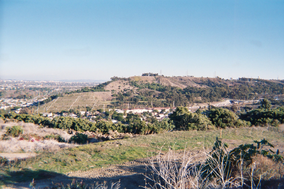Kenneth Hahn State Recreation Area
| Kenneth Hahn State Recreation Area | |
|---|---|

View east of the Kenneth Hahn State Recreation Area Park and the Baldwin Hills, from the Baldwin Hills Scenic Overlook Park
|
|
| Location | Los Angeles County, California, USA |
| Nearest city | Los Angeles, California |
| Coordinates | 34°0′31″N 118°21′55″W / 34.00861°N 118.36528°WCoordinates: 34°0′31″N 118°21′55″W / 34.00861°N 118.36528°W |
| Area | 401 acres (162 ha) |
| Established | 1984 |
| Governing body | California Department of Parks and Recreation |
Kenneth Hahn State Recreation Area, or Hahn Park, is a state park unit of California in the Baldwin Hills Mountains of Los Angeles. The park is managed by the Los Angeles County Department of Parks and Recreation. As one of the largest urban parks and regional open spaces in the Greater Los Angeles Area, many have call it "L.A.'s Central Park". The 401-acre (162 ha) park was established in 1984.
The Baldwin Hills were part of the homeland of the Tongva people, inhabited by them for over 8,000 years. In the 19th century the area was part of the Spanish and Mexican Ranchos of California era, with the Rancho Rincon de los Bueyes and Rancho La Cienega o Paso de la Tijera in and around the present day park. As Los Angeles quickly grew during the 20th century, only the rugged terrain of this section of the Baldwin Hills protected it from being developed.
In 1932 the area east of the park was used as the site of the first Olympic Village ever built, for the 1932 Summer Olympics in the 10th Olympiad, which Los Angeles hosted. Los Angeles later hosted the 1984 Summer Olympics, drawing athletes from 140 nations. To serve as a continual reminder of the events, 140 trees have been planted together on the hills where the 1932 Olympics took place, with each tree representing a nation that took part in the 1984 Olympics.
Between 1947 and 1951 the Baldwin Hills Reservoir was built in the hills on the future park site. In 1963 the reservoir's dam collapsed disastrously, washing away residences in the canyon and flooding the landmark Baldwin Hills Village (now Village Green) at the hills' foot. The news coverage of the disaster was the first time aerial footage was televised live. The reservoir's empty bowl is still visible.
...
Wikipedia


